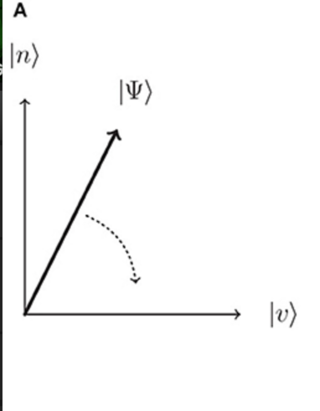Humor
Toward a Quantum Model of Humor
New research uses quantum theory to explain why jokes are funny.
Posted April 6, 2017
Humor is an integral aspect of what it means to be human. Evolutionarily, it is thought to be adaptive. It can forge social bonds, contribute to resilience, and help us cope with difficult situations. It can be used to establish and maintain ‘pecking order’. It is even one of the top things people look for in choosing a mate.
Scholarly research on the cognitive aspect of humor has focused on the bisociation, or “mental synergy” between incongruous mental schemas. For example, consider the joke “Why was 6 afraid of 7? Because of 789.” The humor of this joke hinges on the fact that the pronunciation of the number EIGHT, a noun, is identical to that of the verb ATE. (A word like this with two meanings is sometimes called a homonym.) So this joke is said to involve the bisociation of a numbers schema and a predation schema.
Despite that cognitive science has come forward with formal models of most basic cognitive phenomena such as decision making, categorization, and so forth, there have been few attempts to formally model what is happening in the mind of someone at the instant they get a joke. The exception to this is a few computer programs that have been developed to model how, as a joke unfolds and new contextual information is gained, there is a shift from one interpretation of an ambiguous word or situation to another. For example, given the above-mentioned 789 joke, such a computer program might model the switch from interpreting EYT as the number eight (we call this the ‘numbers’ interpretation) to interpreting it as the verb ATE (we call this the ‘predator’ interpretation). However, the switching from one interpretation of a word or situation to another is not sufficient to generate humor. Humor, as mentioned above, involves the bisociation of incongruous frames: we can see that there is a (perhaps nonsensical) way in which each frame is appropriate. This holding together in the mind of incongruous frames during the instant we ‘get’ a joke is what generates a feeling of giddy excitement referred to as ‘mirth’ that not unlike the ‘Eureka’ experience of insight when we hit upon an idea. It is the pleasure and contagiousness of mirth that makes humor an important and ubiquitous part of human life.
The quantum formalisms provide a natural way of coping with the kind of ambiguity and contextuality that arises in humor. What we use is not the formalisms of quantum mechanics per se, but an abstracted form of them that has been applied to cognitive (and other) phenomena outside the realm of physics in dozens of scientific papers over the last decade and a half. The approach is in the same spirit as chaos theory, which was initially applied only to physical systems but subsequently generalized to model weather patterns, physiological systems, and so forth. It just so happens that the first application of this general approach was to describe the realm of the microworld, but our application has nothing to do with the microworld. (In this sense, it is unfortunate and perhaps misleading that the approach has come to be known as the ‘quantum approach.) Thus, our work is unrelated to efforts that explore how events in the microworld affect the macro structures of the brain.
The reason why quantum probability is potentially useful for modeling the ambiguity and contextuality of humor is that, whereas in classical probability theory, events are drawn from a common sample space, in quantum probability theory, events can be drawn from different sample spaces. States and variables are defined with respect to a particular context, represented using a basis vector in a Hilbert space. This results in the ‘signature’ phenomena of quantum systems: interference, superposition, and entanglement.
It should be mentioned that just because a system is contextual, that doesn’t mean that a quantum formalism is applicable. However, there is something called the law of total probability (LTP) according to which, a system must satisfy the distributive axiom, which states that the total probability of some observable should be equal to the sum of the probabilities of it under sets of more specific conditions. If LTP is violated, then a quantum framework is a viable option. Thus, the LTP can help us determine whether or not a quantum approach is appropriate. Therefore, in this initial application of the quantum approach to humor we both (1) develop a quantum model of humor, and (2) assess the viability of this model by testing the hypothesis that jokes violate LTP.
MODEL AND EXAMPLE
In reading over the following section, it may be helpful to refer to the glossary of terms at the bottom of this blog. Terms that are boldened in the text are defined in the glossary. The glossary includes their definitions in physics as well as their usage in this application to the psychology of humor.
Returning to the 789 joke, an individual’s interpretation of the word EYT is represented by a wave function, which is a vector of length equal to 1. This wave function can be written as a linear superposition of basis states in a complex Hilbert space. The first basis state, which represents the interpretation of EYT as a noun, specifically the number EIGHT, is denoted by one unit vector. The second basis state, which represents the verb interpretation, ATE, is denoted by another unit vector. The set consisting of these two vectors forms a basis in a complex Hilbert space. Thus, our model captures the different possible interpretations of an unfolding joke and their respective funniness using a two-dimensional semantic space.
The model additionally uses a two-dimensional funniness space to represent whether the unfolding joke is viewed as funny. So, there are four dimensions to the Hilbert space in total (two for semantics and two for funniness).
Each vector is associated with an amplitude which, when squared, represents the probability of a listener interpreting the joke in a noun or a verb form respectively. Prior to the joke, these amplitudes represent the prior likelihood of a listener interpreting the uncontextualized word (i.e., EYT) in either of the noun or verb senses. These probabilities evolve throughout the course of the pun as more context is provided (in the form of additional sentence structure). Thus, the state vector evolves to a new position in the Hilbert space.

Since the set-up of the joke, “Why was 6 afraid of 7?”, contains two numbers, initially, the numbers interpretation of EYT is activated. The fact that numbers are not generally beings that experience fear causes the listener to be receptive to an alternative interpretation, i.e., this keeps the interpretation of EYT shifted away from an equivalence with the eigenvector that represents the numbers interpretation. (This also might explain why, in the experiment described below, just the setup of a joke alone, without the punchline, is not rated as completely unfunny.)

Eventually, the predator interpretation that was hinted at in the set-up by the word “afraid”, is reinforced by “789”, which activates the alternative meaning, ATE. This generates a new interpretation: that the number 7 ate the number 9. The cognitive state (i.e., the listener’s understanding of the joke) evolves to a new position in the Hilbert space.

At this point, a ‘measurement’ occurs with respect to the funniness subspace: the individual either considers the joke as funny or not. This is represented as a collapse to the relevant funniness basis state, and the cognitive state reaches its final state in the Hilbert space.
An experimental test of the theory
As mentioned above, it is possible to test the viability of a quantum model using the LTP. In our application of the LTP to humor, the LTP is violated, and therefore a quantum model is appropriate if the mean funniness of a joke as rated by multiple participants does not equal the sum of its funniness as judged under all possible semantic interpretations.
We tested this by collecting funniness ratings of 35 complete jokes (setup + punchline) and joke fragments (e.g., setup only or punchline only) from 85 participants. We found that the funniness of the setup was significantly greater than the sum of the funniness of the setup + the funniness of the punchline. Since we could not be absolutely certain which semantic interpretation the participants in our experiment were giving to a particular joke or joke fragment, we could not conclusively determine that a quantum model is necessary to model this kind of humor. However, the data were so extreme that we do not see any possible way in which the LTP would not be violated. Thus, we believe the experiment provides tentative support for the theory.
Discussions and conclusions
We have developed a preliminary quantum theory of humor and obtained tentative support for the hypothesis that a quantum framework is appropriate for modelling humor. Although more research is needed to refine the model and definitively prove the need for a quantum approach, this early research lays groundwork for a promising new direction forward to understanding one of the most enjoyable and intriguing aspects of everyday human experience.
On a more personal note, one of the things that can be concluded from this research is: humor is a fun topic to study! One component of the study we conducted that was not reported on here (nor in the paper and chapter referenced below) involved inviting the study participants to concoct new, funny (incongruous) versions of the original joke. Some of these new versions were quite creative; I dare say, ingenious! For example: for the 'Why was 6 afraid of 7' joke, one of the participants wrote: "Because seven was a six offender."
Key terms
For term below I have provided its definition in Physics, followed by its application in Psychology. (Unfortunately, this website does not provide a means to make a table.)
Amplitude
PHYSICS: A complex number that represents the contribution of a component basis state to the state of the system as a whole. The square of the absolute value of the amplitude equals the probability that the state of the system ‘collapses’ to that basis state upon measurement.
PSYCHOLOGY: The square of the absolute value of the amplitude equals the probability that the person’s understanding of an ambiguous element of a joke ‘collapses’ to a particular interpretation.
Basis state
PHYSICS: Defines a space that provides a means of interpreting and defining measurements on a state vector. Basis states are represented by unit vectors that form a linear superposition in a complex Hilbert space.
PSYCHOLOGY: A person’s understanding of a joke is represented as a linear superposition of basis states in a complex Hilbert space (e.g., one basis state represents interpretation of EYT as number 8, and another represents interpretation of it as verb ATE.)
Bisociation
PHYSICS: N/A
PSYCHOLOGY: Merger, of incongruous frames or schemas.
Context
PHYSICS: N/A
PSYCHOLOGY: The background situation. Generates a set of expectations that can bias interpretation of ambiguous stimulus.
Entanglement
PHYSICS: Phenomenon wherein entities interact in ways such that the state of one cannot be described independently of the other, even when they are separated by a large distance; a quantum state must be described for the system as a whole. Einstein called this ‘spooky action at a distance’.
PSYCHOLOGY: Entanglement was not the focus of this paper, but it has been the focus of related research on concepts, and its possible role in humor could potentially be investigated.
Frames
PHYSICS: N/A
PSYCHOLOGY: A kind of schema (see below) that is associated with a static image or situation, such as a photograph or cartoon.
Hilbert space
PHYSICS: Generalizes the notion of normal everyday Euclidean space to spaces with any number of dimensions. It is an abstract vector space possessing the structure of an inner product that allows length and angle to be measured.
PSYCHOLOGY: Our model captures the different possible interpretations of an unfolding joke and their respective funniness using a two-dimensional semantic space and a two-dimensional funniness space.
Incongruity
PHYSICS: N/A
PSYCHOLOGY: Situation in which there are incompatible interpretations of an ambiguous stimulus. (For example, EYT can mean either the number 8 or the past tense of the verb ‘ate’, and these are incompatible because it's either one or the other.)
Interference
PHYSICS: The phenomenon wherein waves interact with one another and thereby affect their joint amplitude.
PSYCHOLOGY: Interference was not investigated in the paper and book chapter referenced below, (but beautiful interference patterns have been obtained in related work on concepts).
Law of total probability (LTP)
PHYSICS: States that the total probability of some observable should be equal to the sum of the probabilities of it under sets of more specific conditions.
PSYCHOLOGY: If humor satisfies the LTP, the mean funniness of a joke as rated by multiple participants should equal the sum of its funniness as judged under all possible semantic interpretations.
Observable
PHYSICS: A dynamic variable that can be measured, such as position or momentum. It is associated with a set of different possible outcomes.
PSYCHOLOGY: Our model has two observables: a semantic observable, associated with possible meanings that could be attributed to the ambiguous element of the joke, and a funniness observable, which in this simple model is associated with the outcomes ‘funny’ and ‘not funny’.
Schemas
PHYSICS: N/A
PSYCHOLOGY: A mental structure that organizes categories of information and the relationships among them. ‘Schema’ is a more general term than ‘frame’ because also includes scripts, which unfold over time (e.g., script for what happens in a restaurant).
Superposition
PHYSICS: A sum of multiple solutions (e.g., possible set-ups of an experiment), often with constant factors (amplitudes) in front of each one, which when squared give the probability of that solution. The superposition is itself also a solution. A measurement causes a “collapse” of a superposition of solutions to a single solution. Whether or not something is in a superposition state depends on what you are trying to measure, i.e., the observable.
PSYCHOLOGY: In our case, the ‘solutions’ are possible interpretations of a joke.
Vector
PHYSICS: Basically, a line with a direction.
PSYCHOLOGY: Used to represent an interpretation of the ambiguous aspect of a joke.
Wavefunction
PHYSICS: An equation that contains all the information about the state of a system, i.e., it gives an amplitude (which is similar to a probability) for the likelihood of obtaining a particular outcome given the measurement of a particular observable.
PSYCHOLOGY: Contains all the different possible interpretations of the ambiguous aspect of a joke, and their associated amplitudes.
* N/A Means “not applicable”.
References
Gabora, L. & Kitto, K. (2017). Toward a quantum theory of humour. Frontiers in Physics (Section: Interdisciplinary Physics), 4(53). doi: 10.3389/fphy.2016.00053
Gabora, L., Thomson, S., & Kitto, K. (in press). A layperson introduction to the quantum approach to humor. The psychology and philosophy of humor. Bogotá-Colombia: Ediciones Universidad Cooperativa de Colombia.




